Julia Louis-Dreyfus recently announced her breast cancer diagnosis. This announcement is very timely since October has been designated as breast cancer awareness month. While it might seem impossible to think that there's anything good about breast cancer, fortunately, there is.
According to report, which is published every two years by the American Cancer Society, breast cancer deaths have declined by 39 percent between 1989 and 2015. That's about 322,600 fewer victims of the disease. Additionally, between 2006 to 2015, the gap between racial/ethnic disparities seemed to be narrowing (including Alaskan Natives and American Indians).
Breast cancer is the second leading cause of death in women following lung cancer and is the second most diagnosed cancer in women (after skin cancer). Published in the journal CA: A Cancer Journal for Clinicians, data were collected by the National Cancer Institute's (NCI's) Surveillance, Epidemiology, and End Results (SEER) program and the Center's for Disease Control and Prevention's National Program of Cancer Registries.
Approximately 252,710 new cases of invasive breast cancer (breast cancer which has extended past the basement membrane into surrounding tissue or beyond) and 63,410 cases of in situ breast carcinoma (well demarcated with intact border/no sign of invasion) are expected to be diagnosed among US women in 2017. In addition, 40,610 women are expected to die from this disease in 2017. Eighty-one percent of breast cancers are diagnosed among women ages 50 years and older, and 89% of breast cancer deaths occur in this age group. The median age at diagnosis for women with breast cancer is 62 years for all women, 59 years for black women 63 years for white women. The median age at breast cancer death is 68 years overall (70 years for white women and 62 for black women).
Non-Hispanic white (NHW) and non-Hispanic black (NHB) women have higher breast cancer incidence and death rates than women of other race/ethnicities. Compared with NHW women, NHB women have higher breast cancer incidence rates before age 40 years but lower rates at ages 65 to 84 years. NHB women are more likely to die from breast cancer at all ages.
Declines in breast cancer mortality rates have been attributed to both improvements in treatment (e.g. adjuvant chemotherapy and hormonal therapy in the 1980s and targeted therapies in the 1990s) and early detection by mammography. In contrast to what was once obvious, recent data suggest that the racial disparity may be stabilizing with regard to mortality trends among white and black women, with the latter experiencing greater mortality than the former.
Black-white breast cancer disparity, according to the report, results from a complex interaction of genetic and socioeconomic factors. This shows up as differences in stage at diagnosis, tumor characteristics, obesity, and comorbidities as well as access, adherence, and response to treatments. Hopefully, with improvements in the technology sector, chemotherapy, development of other modes of improved detection, the gap will continue to narrow, and survival will continue to improve.




